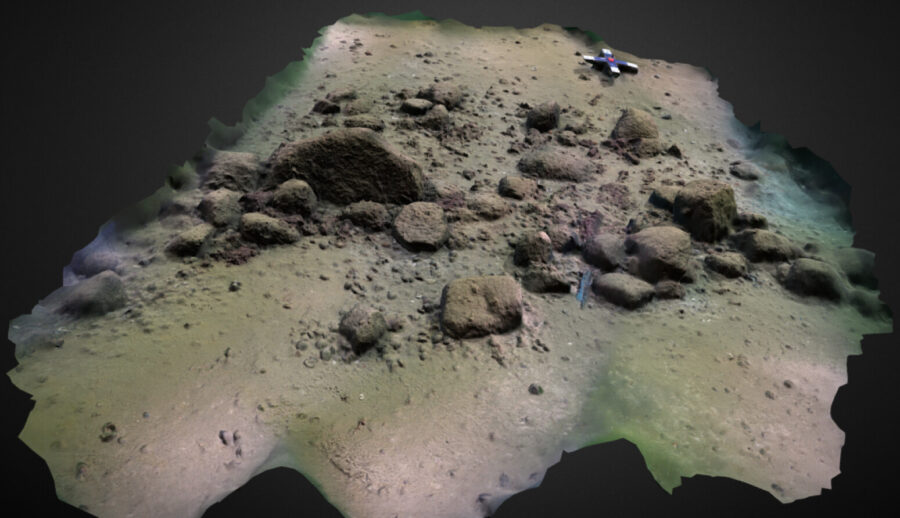Ancient Human Megastructure Discovered Under The Sea And The Mystery Gets Deeper

Scientists have discovered a piece of history beneath the Baltic Sea in Germany’s Bay of Mecklenburg. Located 69 feet (21 meters) below the water’s surface is an ancient stone megastructure that appears to be more than 10,000 years old. Spanning approximately 0.62 miles (1 km), the structure has baffled researchers as it defies natural explanations.
Dubbed the Blinkerwall by the German research team led by geophysicist Jacob Geersen of Kiel University, the megastructure is believed to have aided the hunting efforts of communities in the area millennia ago. “The site represents one of the oldest documented man-made hunting structures on Earth and ranges among the largest known Stone Age structures in Europe,” the research paper says.
The collected data of the megastructure revealed a stretch of 1,670 individual stones, covering approximately 3,186 feet (971 meters).
“It will become important for understanding subsistence strategies and mobility patterns and inspire discussions concerning the territorial development in the Western Baltic Sea region,” the paper added. The change in Earth’s land masses, shaped by tectonic movement, erosion, and climatic processes, has concealed several coastal settlements and megastructures beneath the waves.
However, recent advancements in technology are bringing these hidden treasures to light. Geersen and his team used high-resolution hydroacoustic imaging, an autonomous underwater vehicle, and human divers to explore the bay and map the true extent of the Blinkerwall megastructure. The collected data revealed a stretch of 1,670 individual stones, covering approximately 3,186 feet (971 meters).
The stones, 3.3 feet (less than a meter) high and less than two meters wide, were meticulously arranged. According to the team, the precision and orderliness of the structure are improbable outcomes of natural processes like glacial transport or being pushed by ice. Additionally, the structure seems to be situated near an ancient shoreline or bog.
The site represents one of the oldest documented man-made hunting structures on Earth and ranges among the largest known Stone Age structures in Europe.
However, the researchers dismissed the possibility of the Blinkerwall functioning as a fish weir, as they were unable to identify the necessary water flow for it to work effectively. They also ruled out the megastructure serving as a coastal defense because its width is too narrow for the base of a coastal wall. Constructing a harbor is unlikely since the inhabitants were likely carrying out seafaring activities.

The Blinkerwall megastructure is not an isolated discovery. Similar stone structures have been found across landscapes from the deserts of Saudi Arabia to central Asia. Scientists believe these structures were also used for herding animals, making hunting more efficient. Despite the challenges in dating such structures, the researchers estimate that the Blinkerwall was constructed during the Stone Age.
It is believed to have been submerged beneath the Baltic Sea around 8,500 years ago. “The suggested date and functional interpretation of the Blinkerwall make the feature a thrilling discovery, not only because of its age but also because of the potential for understanding subsistence patterns of the early hunter-gatherer communities,” the researchers added about the megastructure.
Unearthing submerged treasures offers valuable perspectives on prehistoric human behavior, shedding light on ancient hunting landscapes. Furthermore, the exploration and study of diverse ancient megastructures like Alhambra, Petra, Machu Picchu, and Angkor Wat underscore the extraordinary architectural and engineering feats accomplished by ancient civilizations.
Similar stone structures have been found across landscapes from the deserts of Saudi Arabia to central Asia.
The Alhambra is a stunning example of Islamic military architecture in Europe, showcasing intricate design and water management systems. Petra, an ancient city in Jordan, features impressive engineering, including a vast golden dome. Machu Picchu, located in the Andes, demonstrates the incredible construction skills of the Inca Empire.
The Angkor Wat in Cambodia is a humbling representation of the Hindu universe. These megastructures provide valuable insights into the advanced knowledge and skills of ancient societies, inspiring awe and admiration for their enduring legacy.
Source: PNAS












